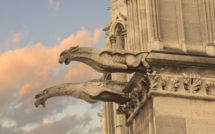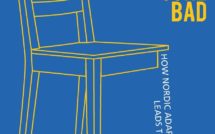

This is part of our special feature on forced migration, Narration on the Move.
As we witness one of the largest movements of people in world history, universities and colleges endeavor to provide refuge for scholars and students. They offer homes, short or long term, for people fleeing oppression, injustice, and poverty. They create a space for reflection upon the universal ideals of education and collective action toward attaining them. How and where did these notions arise? Was it in the 1960s with the anti-war, civil rights, and feminist movements? In the inter-war years as a challenge to fascism? Important though all these moments are, medieval scholars take a longer view of this tradition, dating it to the very origins of the university as we know it today. To understand the university as a place of refuge, we must look back to the twelfth century in Europe, and even beyond Europe, to examine the diverse roots of this system and the dynamic social world that it represented.
In early medieval Europe, education largely centered around the monastery and was dominated by the clergy. Apart from the wealthiest and most powerful families who could afford private tutors, most young men and women seeking an education either entered holy orders or traveled to one of these monasteries and lived for a time among the community. There they received instruction in the seven liberal arts, with an emphasis on memorization and rote learning. Students could also pursue an education in larger towns that functioned as diocesan centers if the local bishop sponsored a cathedral school. It was at these cathedral schools that the university first took shape and began to grow in the 12thcentury.[1]
Demographic changes like rising population and rapid urban development across Europe contributed to the growth of cathedral schools, but the biggest factor in their increased popularity had to be the exciting shift in curricular content. This shift would not have occurred without the sophisticated work of Islamic and Jewish scholars whose access to ancient texts and traditions far surpassed that of Latin Christians. During the twelfth century a number of important Greek texts by Aristotle, Euclid, Ptolemy, Galen and others that had been all but lost in Western Europe were recovered thanks to the efforts of scholars who found these texts—in Arabic—in Muslim Spain and Sicily and translated them along with learned Islamic and Jewish commentaries.[2] This process of translation and transmission fed the sparks lit by Abelard and others who had no direct access to these rich works. Beginning in the late eleventh century, texts of Roman law compiled under Emperor Justinian were also reintroduced in Northern Italy, possibly from Southern Italy or Byzantium, paving the way for major advances in the study of civil and canon law. In places like Paris, Bologna, and Oxford, cathedral and other schools grew so rapidly that they morphed into universities during the twelfth century.
All of this growth took place long before campuses, deans, and presidents ever existed. How on earth did they manage, and who ran these institutions? For a long time, professors taught classes and students lodged in rented rooms; fees were negotiated between student and instructor; a formal examination was arranged at the end of a few years of study, where the successful candidate would receive the equivalent of a diploma. A university was not a set of buildings, it was a guild (Latin: Universitas). The earliest such guild was formed at Bologna in the mid-twelfth century or earlier, by foreign students who worked to ensure fair food and lodging prices from local townspeople and protections from unscrupulous professors. As Charles Homer Haskins puts it, “Far from home and undefended, they united for mutual protection and assistance, and this organization of foreign, or Transmontane, students was the beginning of the university.”[3]
Like urban guilds of merchants or craftsmen, students bonded out of mutual interest and security, but their goal was very different. Instead of financial profit, student guilds sought unfettered access to learning. The earliest “university” was formed as a refuge for students. Other schools soon followed suit and student guilds looked to establish regulations regarding the start and end time of classes, the quality of lectures, and clearly stated expectations from professors (the origins of today’s syllabi).
Slightly later, professors, especially in northern cities like Paris, began to form guilds known as collegia or universitates to protect their interests. Professors sought to ensure that members of the guild were adequately trained and that they agreed upon who would teach which subjects, as well as when and where. Regardless of whether the impetus came from students, professors, or both, the first universities were corporations that reflected the goals and ideals of large groups of scholars. They did not take orders from wealthy founders, kings, or even bishops, despite their origins as religious schools. While concerns about heresy ensured that no one had complete academic freedom to say whatever they pleased, a surprising amount of latitude was extended to both faculty and students.
Perhaps the greatest marker of protection was the legal privilege accorded to students (and faculty) as members of the clergy.[4] Students did not need to take holy orders to enjoy the temporary status of clergymen (Clerici or “clerks”), which brought with it the “benefit of clergy.” This meant that students who were accused of crimes were placed under the jurisdiction of their school or local clerical leaders, who almost always dealt more mildly with their accused crimes—a useful practice in the wake of the occasional town and gown riot. This is yet another potent example of the university as refuge.
Unlike today, the medieval university was a movable refuge as well. The unique status of early universities as collectives of people (not buildings) and their compelling sense of their shared rights enabled them to move to other cities if the town’s merchants were trying to gouge them or the local authorities mistreated them. A neighboring city was very likely to welcome university members and their business; the recent relocation of Central European University from Budapest to Vienna is a reminder of this tradition. Finally, the movable position of medieval universities is worth remembering as we debate the merits of digital classrooms, open-access models, and the idea of the “global campus” today.
Towns and townspeople, despite moments of friction, contributed more to university culture than they took away. Arguably, universities would not have come into existence without the vibrant, diverse setting of town life. Urban centers attracted visitors from afar- often from beyond Europe, to trade their wares, do business, pray at shrines, seek audiences with secular or religious leaders, or make use of the courts. They offered bold examples to scholarly observers of the wonders that powerful, well-organized guilds could achieve. Putting aside important considerations of housing, access to necessities of life, and easy access to roads and waterways to reach the schools, it is hard to imagine the lively intellectual culture of the university springing from the soil of the countryside, much less within the walls of a monastery where one was expected to live by its rules. Towns, then as now, were hubs of cosmopolitan culture. In turn, the presence of universities added to that diversity as students flocked to schools from across and sometimes outside of Europe. By the later Middle Ages some universities had endowed colleges with dormitories that charitably housed poor students, bringing economic and social diversity to towns while minimizing the threat of failure and isolation that lower-class workers often faced.
Just how inclusive were medieval universities? Here the exuberant narrative of freedom and common enterprise falls short. By and large, the medieval university was home only to Catholic Christian men. There are indications of women in the margins of universities as medical practitioners and lecturers, as seen in the famous gynecological text called the Trotula, attributed in part to the female practitioner Trota of Salerno, and a handful of other examples of female instructors.[5] But women as a rule were primarily not allowed to enroll as students as they could not occupy the position of the male cleric. It was not until 1678 that a woman, Elena Lucretia Cornaro-Piscopia, received a Ph.D. The University of Padua awarded her the degree, but she was not allowed to attend classes with male students; all her instruction took place in her home with private tutors from the faculty of Padua. It was an important first, but one that few women had the means to emulate.
Because of the clerical status of students, Jews and Muslims would also have found it difficult if not impossible to attend universities at this time—even though much of the university curricula owed its very existence to Muslim and Jewish scholarship. If they were admitted, they would have found themselves in a less than congenial environment: many or most polemical writings against Islam and Judaism in this period were written by university faculty. Universities could also be the site of rigged debates between Christians and Jews and investigations into their writings. The Talmud was condemned in Paris at the behest of Louis IX of France in 1244.[6] That said, from the sixteenth to the eighteenth centuries, many Jews from across Europe attended and graduated from the University of Padua with degrees in medicine; before this, there were fewer examples of Jews attending universities for medical training, but it was not completely unheard of.[7] Statutes prohibiting non-Christians from attending university, such as the one published at Perpignan (c. 1389), would suggest that they were in attendance before this time.[8] These are important instances and more may yet be found as research continues, but the overall number of non-Christians must have been very small compared to male Christian graduates in the medieval and early modern periods.
Ironically, for all this exclusion, we would do well to remember that universities recruited faculty to teach “Eastern languages” as well as Greek and Hebrew.[9] The main goal was conversion, but as these fields grew in sophistication, they led to broader intellectual developments. The Church may have intended to squelch religious differences with this linguistic knowledge, but it broadened the cultural horizons of generations of university students in the process.
There were moments in this period when the university functioned as a place of refuge in the most immediate sense, as Greek scholars fleeing the Ottoman advance in Byzantium during the fifteenth century found. They were not all welcomed with open arms and some had to endure offensive stereotypes about their beards and other cultural differences, but many learned refugees were eagerly invited to teach at Italian studii and universities in the fifteenth century and following.[10] The arrival of these Greek scholars expanded and improved the fledgling study of ancient Greek texts, particularly in Platonic and Aristotelian philosophy; their impact on Renaissance learning, particularly ancient Greek studies, is hard to overstate. All or most of these Greeks, it should be noted, were Catholic or Uniate Christians who recognized the pope—Orthodox Christians would not likely have received so warm a welcome after many failed efforts to heal the schism. It also bears mentioning that the Ottoman Empire accepted at least as many scholarly refugees as its wars of expansion created. Ottoman rulers provided a home for Jewish refugees fleeing Spain after 1492, if not in western-style universities, then certainly in other settings.
While diversity in faculty and student bodies in European (and American) universities would not be achieved during the medieval period, the multicultural roots of universities were found in the texts they studied from the very beginning, particularly translations and analyses by Muslim and Jewish scholars, in Muslim Spain and Sicily, of ancient Greek texts which were brought to twelfth-century Europe. Let this be a lesson to anyone today who tries to claim that “European learning” was solely the work of white Christians. Perhaps more importantly, we must remember that from its very origins, the university was both a product of student and faculty self-determination and a safe haven against violence and government interference. The commitment to the university as a place where professors and students shaped the rules and expectations, banded together in guilds, and generally protected each other was the heart and soul of the university from the moment it was conceived—it is a heritage that must be remembered and defended today as increasing numbers of students and scholars are displaced around the world. In the best of circumstances, governments felt their obligation to ensure the protection of scholars during times of war. If haughty King Philip the Fair could assert his protection of Flemish students and masters at the universities of Paris and Orleans during the war between France and Flanders in 1297,[11] how much more should modern governments and universities safeguard the rights of scholars from abroad to teach and to learn in modern versions of that illustrious medieval invention?
Nancy Bisaha is Professor of History and Director of Medieval and Renaissance Studies at Vassar College. Her recent work includes Creating East and West: Renaissance Humanists and the Ottoman Turks (UPenn Press), a study the ways in which humanists created an intellectual discourse depicting the Ottoman Turks as a cultural and religious other, and a translation of Aeneas Silvius Piccolomini’s De Europa in collaboration with Robert Brown. She is currently working on a study of Pope Pius II and the rise of the modern concepts of Europe and the West.
References:
Bisaha, Nancy. Creating East and West: Renaissance Humanists and the Ottoman Turks. Philadelphia: University of Pennsylvania Press, 2004.
Monica H. Green, ed. and tr. The Trotula: an English translation of the medieval compendium of women’s medicine. Philadelphia: University of Pennsylvania Press, 2002.
Haskins, Charles Homer. The Rise of Universities. Ithaca: Cornell University Press, 1923; reprinted, 1990
Riddle, John. A History of The Middle Ages, 300-1500. Lanham, Mass.: Rowman & Littlefield, 2008.
Roth, Cecil. “The Qualification of Jewish Physicians in the Middle Ages.” Speculum 28, no. 4 (1953): 834-43.
Ruderman, David B. “The Impact of Science on Jewish Culture and Society in Venice.” In Essential Papers on Jewish Culture in Renaissance and Baroque Italy, ed. David B. Ruderman. New York: New York University Press, 1992.
Lynn Thorndike, ed. University Records and Life in the Middle Ages (New York: W.W. Norton, 1975)
Wallis, Faith, ed. Medieval Medicine, A Reader. Toronto: University of Toronto Press, 2010.
Williams, Marty, and Anne Echol. Women in the Middle Ages: Between Pit and Pedestal. Princeton: Markus Wiener Publishers, 1994.
[1] A good overview of the origins of universities may be found in the classic work by Charles Homer Haskins. See The Rise of Universities (Ithaca: Cornell University Press, 1923; reprinted, 1990). See also John Riddle, A History of The Middle Ages, 300-1500 (Lanham, Mass.: Rowman & Littlefield, 2008).
[2] The translations of Arabic medical texts by Constantine the African at Salerno in the late 11th century were also important. See Faith Wallis, ed., Medieval Medicine, A Reader (Toronto: University of Toronto Press, 2010), 135-38.
[3] Haskins, Rise of Universities, 8.
[4] See, for example, Pope Alexander III’s defense of student privileges, c. 1170 in Lynn Thorndike, ed. University Records and Life in the Middle Ages (New York: W.W. Norton, 1975), 19-20.
[5] Little is known for certain about the precise authorship of Trotula. See Wallis, Medieval Medicine, 185 ff. See also The Trotula: an English translation of the medieval compendium of women’s medicine, ed and tr. Monica H. Green
(Philadelphia: University of Pennsylvania Press, 2002). On cases of women lecturers, see Marty Williams and Anne Echols, Women in the Middle Ages: Between Pit and Pedestal (Princeton: Markus Wiener Publishers, 1994), 215-16.
[6] Thorndike, ed. University Records, 48-50.
[7] David B. Ruderman, “The Impact of Science on Jewish Culture and Society in Venice,” in Essential Papers on Jewish Culture in Renaissance and Baroque Italy, ed. David B. Ruderman (New York: New York University Press, 1992), 519-21. For other possible examples of Jews at universities, see Cecil Roth, “The Qualification of Jewish Physicians in the Middle Ages,” Speculum 28, no. 4 (1953): 834-43.
[8] It prohibits instruction of “a Jew or Saracen or anyone else of whatever alien sect he may be,” Thorndike, ed., University Records, 257.
[9] See Thorndike, ed., University Records, 68-70, 297-98.
[10] See Nancy Bisaha, Creating East and West: Renaissance Humanist and the Ottoman Turks (Philadelphia: University of Pennsylvania Press, 2004), 104-32.
[11] Thorndike, ed., University Records, 124-25.
Photo: Silhouette profiles of multiracial people. Intercontinental dialogue. Group of people of different ages and nationalities | Shutterstock
Published on October 29, 2019.




